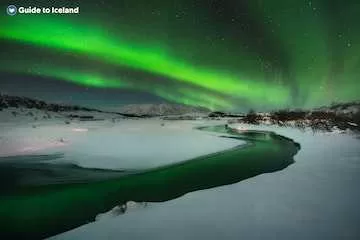
Iceland? In The Winter?
Ok, before you decide that visiting Iceland in the winter is the worst idea that you have ever heard and go running to the nearest website promising you suntans and coconuts filled with rum and paper umbrellas, give me a chance here. Remember the words of Maria in Mighty Ducks: D2
Greenland is covered in ice, Iceland is really nice
I know, it might not be the deepest thing that you’ve ever heard. And, yes, in the winter especially, Iceland will be covered in Ice as much as Greenland. But, even so, the truth still holds. Iceland is really nice. Even in the middle of winter.
Even Without the Midnight Sun, the Skies are Still on Fire Because of the far northern location of Iceland (along with Alaska, Norway, Sweden, Finland and Greenland) night time presents one of the most amazing light shows in the world: the Northern lights, or Aurora Borealis. Those of us that live further south will get the chance to see them on rare occasion. I’ve seen them in New Hampshire and southern Canada a smattering of times. The further north that you go, the more reliable and stunning they become: shimmering dancing curtains of green, yellow and blue light. Sometimes even red.
In the past, people came up with all sorts of explanations: my personal favorite is that they are the souls of unwed women who have died. Today we know that they are caused by solar radiation interacting with the earth atmosphere. This explanation doesn’t change the fact that the Northern lights are one of the most
beautiful sights that a person can hope to see.
Every year, countless tourists flock to the Northern countries with the hopes of seeing the lights. No small number take advantage of their summer holidays, head up North for a week…
…and realize that they forgot something. In the summer, the sun barely sets, if at all. You can’t see the northern lights in Iceland (or anywhere else) unless it gets dark enough so that you have a chance of seeing them!
Now, you might be thinking, that it’s all well and good that you can only see the northern lights if it’s the middle of winter, but no lightshow is worth standing outside in the freezing cold just on the off chance that you’ll see something flicker.
This is why Iceland is the best place to go! Iceland is overflowing with volcanic activity. The happy upshot of this is that every town, and many of even the smaller hotels have their own outdoor hot tubs that are naturally heated. Get out of Reykjavík (maybe pop up to the northern capital of Akureyri) and get away from the city lights. Share a bottle of schnappes with your travelling mate and as the steam swirls around you, keep an eye out for the Northern lights, shooting stars and whatever else may be up in the sky.
Will I Be Able to Enjoy Anything Else in Iceland?
It is true that many of Iceland’s museums and other attractions will be closed, or have greatly reduced hours during the winter. But, don’t let that stop you. The natural resources never quit. The Golden circle becomes even more impressive in the winter. Gulfoss waterfall is stunning anytime of year, but when the waterfall consists of frozen cataracts, a stilled waterfall, it will fill you with awe.
Geysir (the erupting water plume after which all others are named) bursts forth out of the frozen ground, as much as 65 meters high. The contrast is impossible not to appreciate.
Þingvellir is astounding in the winter, and you’ll have a once in a lifetime opportunity if you come in the winter. Scuba diving or snorkeling in the chasm between Europe and North America while wearing a drysuit. The water is some of the clearest in the world, with visibility for hundreds of meters. Special tours
are easily arranged and you will have a story to tell your friends back home to settle any doubts that you are the most adventurous person that they have ever met.
Iceland is notoriously expensive. Despite the recent economic issues, Iceland is still not a cheap destination. That being said, you can really cash in by visiting Iceland in the winter. Many hotels cut rates by as much as 50%. That means more money in your pocket to stay a few extra days, or really splurge on a nice meal. Also, by going in the off-season you’ll get to have Iceland to yourself. So, you’ll have more money–fewer other tourists. Sounds like a win to me.
Let Your Inner Viking Go Berserk
January 22 through Feb 22 is when Icelanders go back to their Viking roots and celebrate the midwinter feast of Þorrablót. The feast originated as a celebration that winter was halfway completed and that
people had survived. Traditionally, people would save the finest foods (most of which had been put aside to ferment the previous year) and begin consuming them on the holiday. Delicacies include putrefied shark, jellied sheep’s head, dried fish. These foods are pretty much only consumed during the holiday.
This is your only chance to really taste these traditional foods. Sure, they aren’t likely to be topping any international menus in the near future, but as far as unique food opportunities go, this is pretty high up there.
If the flavor gets you down, the good news is that there is plenty of brennivín (an Icelandic schnapps) to wash it down. The common nickname is Black Death, and it is especially potent. You can be sure that after a few drinks, you’ll be ready to join everyone in the rest of the evening celebrations of song and dance.
If you’re looking for sunshine, sand and a killer tan, Iceland will not be the place to go in January. But, if you’ve got an urge to really go off the beaten path and have experiences that most other people will only ever read about, why not explore this northern country. Give yourself the gift of an experience that you will truly remember for years to come.
AUTOPOST by BEDEWY VISIT GAHZLY

